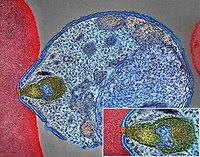
Photo from wikipedia
As part of the investigation of the distribution of ambient dose equivalent rates around the Fukushima Dai-ichi Nuclear Power Plant (FDNPP), car-borne surveys using Kyoto University RAdiation MApping (KURAMA) systems… Click to show full abstract
As part of the investigation of the distribution of ambient dose equivalent rates around the Fukushima Dai-ichi Nuclear Power Plant (FDNPP), car-borne surveys using Kyoto University RAdiation MApping (KURAMA) systems have been conducted over a wide area in eastern Japan since 2011. The enormous volume of measurement data collected until 2016, including those until 2012 which were reported in the previous paper, was analyzed, and dependencies of the decreasing trend of the dose rates in regions within 80 km of the FDNPP on land-use categories, evacuation order areas and magnitude of the dose rates were examined. The air dose rates within 80 km of the FDNPP tended to decrease considerably with respect to the physical decay of radiocaesium. The decrease of the dose rate in the "forest" was slower than its decrease in other regions, while that in "urban area" was the fastest. The decrease in the air dose rate from 2011 was the fastest outside the evacuation order area until 2015, and it was the slowest in the "difficult-to-return zone". However, the decreasing trend starting from 2013 showed that the decrease in the "zone in preparation for the lifting of the evacuation order" and in the "residence restriction area" was the fastest. It was found that the air dose rates decreased depending on the magnitude of the dose rates and elapsed time from the FDNPP accident, i.e. the decrease in air dose rates in areas with relatively low dose ranges (such as 0.2-0.5 μSv/h) was the largest during a period relatively early after the accident, and the decreasing rate in the dose rate ranges of 1.9-3.8 and 3.8-9.5 μSv/h were the fastest after 2013. The averaged ratios were analyzed to obtain the ecological half-lives of the fast and slow decay components, and those in whole area within 80 km of FDNPP were estimated to be 0.44 ± 0.05 y and 6.7 ± 1 y, respectively. The ecological half-lives with respect to the land use categories, evacuation order areas and magnitude of the dose rates were also evaluated. The decrease in the dose rates obtained by the car-borne survey was larger than that obtained on flat ground with few disturbances using the NaI(Tl) survey meter during approximately 1.5 y after the FDNPP accident. Thereafter, the difference of decreasing tendencies in the air dose rates between both the measurements was negligibly small, with the ratio of dose rates by the car-borne survey to those by the fixed-point measurement of 0.72-0.77.
Journal Title: Journal of environmental radioactivity
Year Published: 2018
Link to full text (if available)
Share on Social Media: Sign Up to like & get
recommendations!